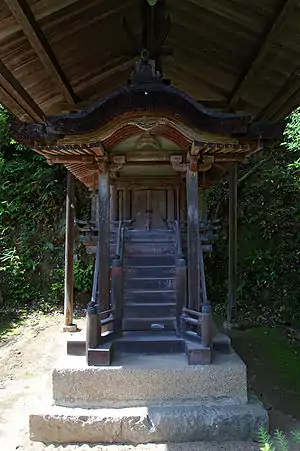Enjō-ji
Enjō-ji (円成寺) is a Shingon temple in the northeast of Nara, Japan. A number of its buildings and images have been designated National Treasures and Important Cultural Properties, and its late-Heian period gardens are a Place of Scenic Beauty.
| Enjō-ji (円成寺) | |
|---|---|
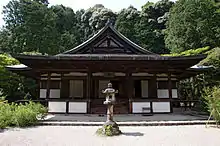 Enjō-ji Hondō of 1472, an Important Cultural Property | |
| Religion | |
| Affiliation | Omuro Shingon |
| Deity | Amida Nyorai (Amitābha) |
| Location | |
| Location | 1273 Ninnikusen-chō, Nara, Nara Prefecture |
| Country | Japan |
 Shown within Japan | |
| Geographic coordinates | 34°41′45″N 135°54′55″E |
| Architecture | |
| Founder | Xulong, Emperor Shōmu & Empress Kōken |
| Date established | 756 |
| Website | |
| http://www.enjyouji.jp/ | |
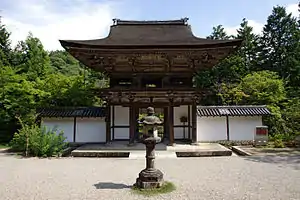
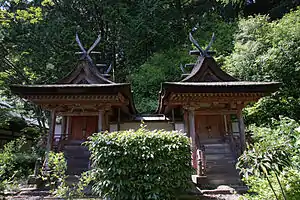
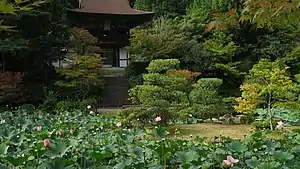
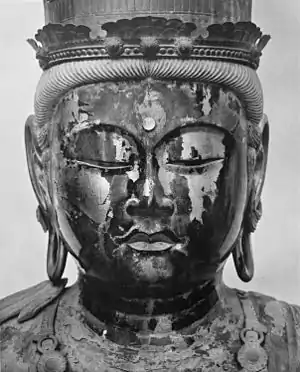
History
Enjō-ji is said to have been founded in 756 by a Chinese priest who accompanied Ganjin to Japan. The temple was enlarged in the late-Heian and Muromachi periods. Much damage occurred during the Ōnin War and further losses occurred during the Meiji period and after.[1][2]
Buildings
The two-storey gate of 1468 and Hondō of 1472 are both Important Cultural Properties.[3][4] The tahōtō is lost and has been replaced with a modern replica.[5]
Also on the grounds are a number of Shinto shrines. The single bay Kasugadō and Hakusandō of 1227/8 are the oldest extant examples of kasuga-zukuri and are thought to have been moved from Kasuga-taisha when it was rebuilt.[6] In 1953 both buildings were designated National Treasures.[7][8] The Honden of the shrine to Ugajin dating to the end of the Kamakura period is an Important Cultural Property.[9]
Treasures
In the tahōtō is a seated wooden statue of Dainichi Nyorai (木造大日如来坐像) of 1176 by Unkei. Of Japanese cypress using the yoseki-zukuri technique, it is gilded over lacquer and has crystal eyes. In 1920, it was designated a National Treasure.[10] In the Hondō is a seated wooden statue of Amida Nyorai (木造阿弥陀如来坐像) of the Heian period, surrounded by wooden statues of the Shitennō (木造四天王立像) of the Kamakura period, all Important Cultural Properties.[11][12] Other images include a Jūichimen Kannon of 1026, a child prince of 1309 that has been designated a Prefectural Cultural Property, a Fudō Myōō of the Nanboku-chō period, and a gilded Yakushi Nyorai.[2] The gorintō of 1321 has also been designated an Important Cultural Property.[13]
Gardens
The temple gardens are a rare example of late-Heian Pure Land paradise gardens and in 1973 were designated a Place of Scenic Beauty.[5][14]
See also
References
- Plutschow, Herbert E. (1983). Historical Nara. The Japan Times. p. 151. ISBN 4-7890-0226-8.
- "History, Images". Naranet. Retrieved 31 March 2011.
- "Database of National Cultural Properties". Agency for Cultural Affairs. Retrieved 31 March 2011.
- "Database of National Cultural Properties". Agency for Cultural Affairs. Retrieved 31 March 2011.
- "Enjoji Temple". Nara Prefecture. Archived from the original on 27 September 2011. Retrieved 31 March 2011.
- Kazuo, Nishi; Kazuo, Hozumi (1985). What is Japanese Architecture? A survey of traditional Japanese architecture. Kodansha. pp. 42f. ISBN 978-4-7700-1992-9.
- "Database of National Cultural Properties". Agency for Cultural Affairs. Archived from the original on 7 June 2012. Retrieved 31 March 2011.
- "Database of National Cultural Properties". Agency for Cultural Affairs. Archived from the original on 7 June 2012. Retrieved 31 March 2011.
- "Database of National Cultural Properties". Agency for Cultural Affairs. Retrieved 31 March 2011.
- "Database of National Cultural Properties". Agency for Cultural Affairs. Archived from the original on 7 June 2012. Retrieved 31 March 2011.
- "Database of National Cultural Properties". Agency for Cultural Affairs. Retrieved 31 March 2011.
- "Database of National Cultural Properties". Agency for Cultural Affairs. Retrieved 31 March 2011.
- "Database of National Cultural Properties". Agency for Cultural Affairs. Retrieved 31 March 2011.
- "Database of National Cultural Properties". Agency for Cultural Affairs. Retrieved 31 March 2011.
